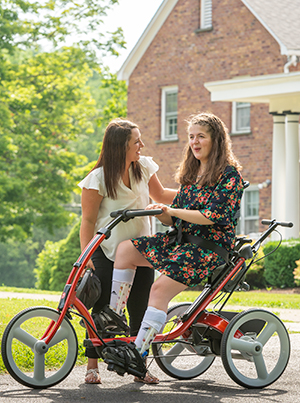Rifton ‘moves needle’ for adaptive cycling equipment

By Liz Beaulieu, Editor
Updated 10:16 AM CDT, Fri July 7, 2023
 RIFTON, N.Y. – A new policy brief supported by Rifton makes the case for Medicare coverage and reimbursement for adaptive cycling equipment (ACE) for individuals with neurodevelopmental disabilities.
RIFTON, N.Y. – A new policy brief supported by Rifton makes the case for Medicare coverage and reimbursement for adaptive cycling equipment (ACE) for individuals with neurodevelopmental disabilities.
Here’s what Zach Huleatt, a physical therapist and director of research and development for Rifton, which provided a small honorarium to the brief’s authors, had to say about how increased physical activity can reduce the risk of costly secondary conditions and why collaboration is so important to advancing a cause.
HME News: Why is a policy brief a good step forward in getting coverage and reimbursement for ACE?
Zach Huleatt: We all recognize the need for collaborative advocacy to move the needle toward policy changes. From the manufacturer and clinician perspective, we know that clinically, there’s a lot of uptake, and from the end user perspective, we know they love it. We get a lot of customer feedback from parents who are overwhelmed having their child smiling and exercising. But we know it takes more than that for it to be funded.
HME: Without Medicare coverage, how is ACE typically accessed today?
Huleatt: The most common funding is through waiver programs in some states. These programs are often obscure and difficult to get a hold of. If you have a parent who is a strong advocate and who has the time and resources to get into that, they can be successful. But even then, you have a physical therapist or other people writing a letter of medical necessity who are not reimbursed for their time. That’s why we need a policy-level acknowledgement that there are benefits to these products, so there’s more access to funding.
HME: What argument does the policy brief make for covering and reimbursing ACE?
Huleatt: To improve access through policy change, it’s going to take an effort to demonstrate the downstream benefits, including to the health care system. People with neuromuscular disorders have a higher risk of secondary conditions and a lower likelihood of reaching the standard dosage of physical activity. When you have a higher risk of a sedentary lifestyle, you have a higher incidence of chronic disease.
HME: What are the next steps in moving these efforts forward?
Huleatt: It comes back to that collaboration. We’re reaching out to the Clinician Task Force and NCART, for example. This opens up channels to get information to the places where it really matters. We’re not effective when we work in isolation.
Comments